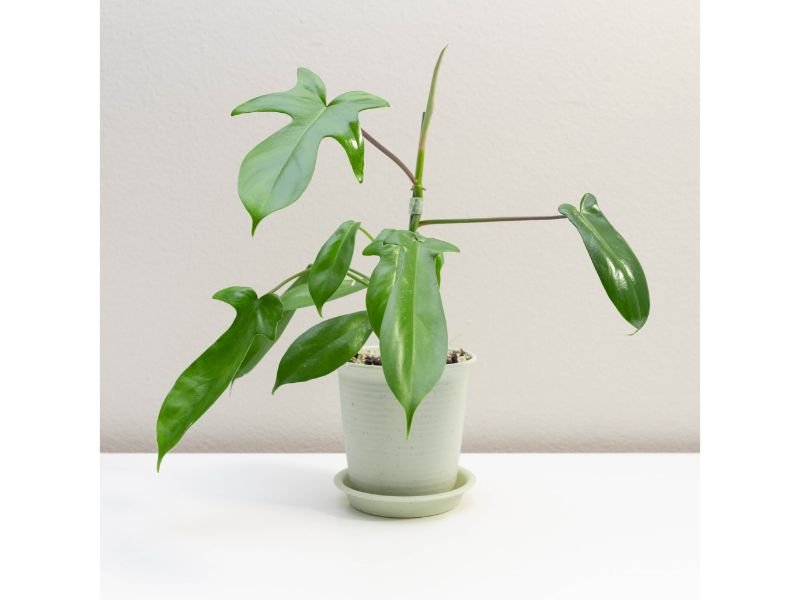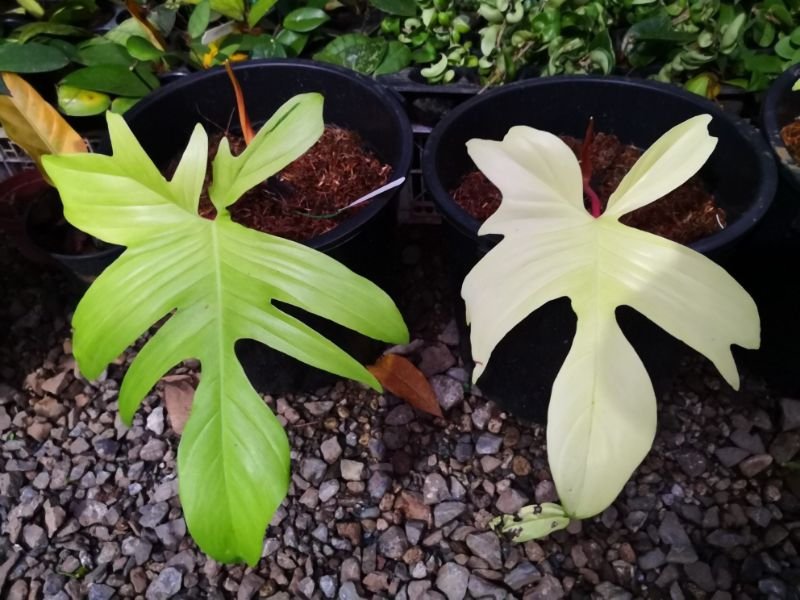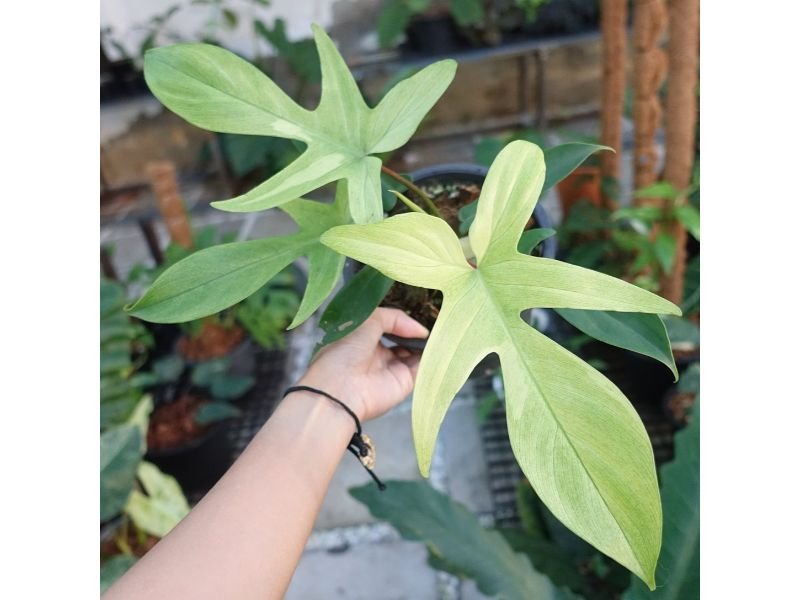Both the Philodendron Florida Green Vs Ghost are hybrid species from the same plant parent but differ in color and size. While Philodendron Florida Green is more notable for their lush green foliage, Philodendron Florida Ghost, as its name states, has that ‘spooky’ milky white or greenish-white foliage.

Both plants have that 5 lobe-shaped foliage that ‘eerily’ resembles a flying ghost, and the color of their foliage will get darker as they age. They also share the same stem characteristic, where it’s thin and deep dark red or dark maroon. Both can be grown as vining or climbing plants too.

In terms of size, Philodendron Florida Green is a little bit taller than its ‘twin sister’, reaching about 4 meters tall or less. At maturity, the Philodendron Florida Ghost will grow to about 1.5 meters or as small as just 60 centimeters. Although it’s widely believed that the Florida Green and the Florida Ghost are a hybrid result of squamiferum x pedatum, there’s no exact scientific information to support this claim.
Care and Maintenance
When it comes to caring for Philodendron Florida Green vs Ghost, there are some similarities and differences to consider. Both plants are native to tropical regions and prefer warm, humid environments. However, there are some key distinctions to keep in mind when it comes to light, water, and temperature requirements.

Philodendron Florida Green, also known as the “compacta,” is known for its dense, compact growth habit and dark green leaves. It prefers bright, indirect light and should be kept away from direct sunlight. It’s important to keep the soil consistently moist, but not waterlogged. This plant thrives in temperatures between 60-90 degrees Fahrenheit.
On the other hand, Philodendron Ghost, also known as “Thaumatophyllum bipinnatifidum,” is known for its large, glossy leaves and trailing habit. It prefers medium to low light and can tolerate lower light conditions than Philodendron Florida Green. It is important to allow the soil to dry out slightly between watering, but not to let the plant dry out completely. This plant also thrives in temperatures between 60-90 degrees Fahrenheit.

In terms of care and maintenance, both Philodendron Florida Green and Philodendron Ghost are relatively low maintenance plants, but they do have different light and watering preferences. Philodendron Florida Green prefers bright, indirect light and consistently moist soil, while Philodendron Ghost prefers medium to low light and slightly drier soil. Both plants are suitable for indoor or outdoor cultivation in warm, humid environments.
Propagation
Propagating Philodendron Florida Green vs Ghost can be done through a few different methods, including stem cuttings and air layering. The success rate of propagation will vary depending on the method and the plant’s growing conditions.
Stem cuttings are a common method for propagating Philodendron Florida Green. To take stem cuttings, snip a healthy stem about 4-6 inches long, remove the lower leaves, and place the cutting in a container filled with moist potting soil or a mixture of peat moss and perlite. Keep the cutting in a warm, humid area with bright, indirect light and keep the soil consistently moist. The cutting should develop roots within 4-6 weeks, at which point it can be transplanted into a larger container. The success rate of stem cutting propagation for Philodendron Florida Green is high.
Air layering is another method for propagating Philodendron Florida Green. To air layer, make a small incision in the stem, dust it with rooting hormone, and wrap it with moist sphagnum moss. Keep the moss moist and cover the area with plastic wrap. Roots will form at the incision site within 4-6 weeks, after which the stem can be cut below the roots and transplanted into a container. The success rate of air layering propagation for Philodendron Florida Green is high.
Philodendron Ghost is also propagated through stem cuttings, with the same steps as Philodendron Florida Green. The success rate of stem cutting propagation for Philodendron Ghost is high, just as Philodendron Florida Green.
In general, both Philodendron Florida Green vs Ghost are relatively easy to propagate through stem cuttings and air layering. Both plants will typically develop roots within 4-6 weeks and can be transplanted into larger containers. The success rate is high for both plants.
Conclusion
In conclusion, Philodendron Florida Green vs Ghost are two popular tropical plants that are known for their lush, green leaves and easy care requirements. Both plants prefer warm, humid environments and can be grown indoors or outdoors. However, there are some distinct differences in their ideal growing conditions, including light, water, and temperature requirements.
Philodendron Florida Green, also known as the “compacta,” prefers bright, indirect light and should be kept away from direct sunlight. It requires consistently moist soil and thrives in temperatures between 60-90 degrees Fahrenheit. On the other hand, Philodendron Ghost, also known as “Thaumatophyllum bipinnatifidum,” prefers medium to low light and can tolerate lower light conditions. It requires slightly drier soil and also thrives in temperatures between 60-90 degrees Fahrenheit.
Both plants can be propagated through stem cuttings and air layering, and the success rate of propagation is high for Philodendron Florida Green vs Ghost.
In terms of which plant may be best for specific situations or preferences, it depends on the space you have and the light conditions. If you have a bright, indirect light room, Philodendron Florida Green would be a great choice. If you have a room with medium to low light, Philodendron Ghost would be a good choice. Both plants are easy to care for and will bring a lush, tropical vibe to any space.

Gardening is my passion and growing plants indoors has always been a stress relief for me. Grow a banana tree in my apartment once (although failed to produce bananas).






